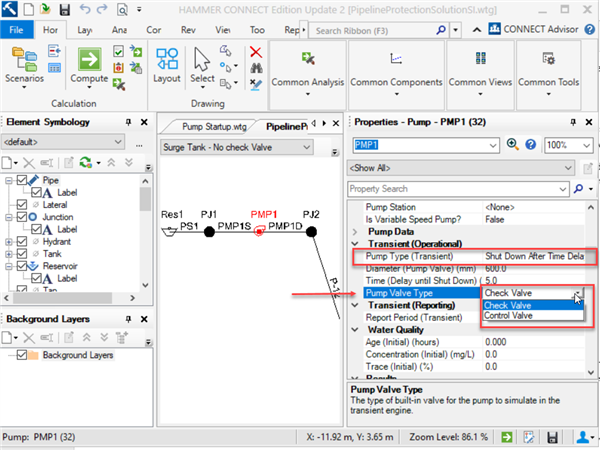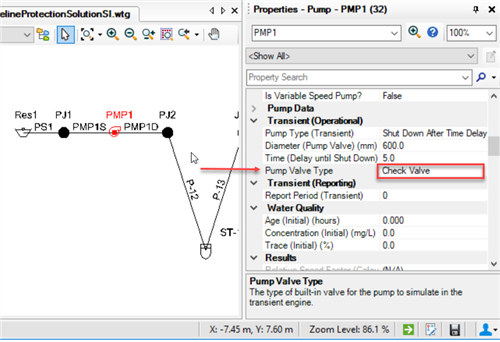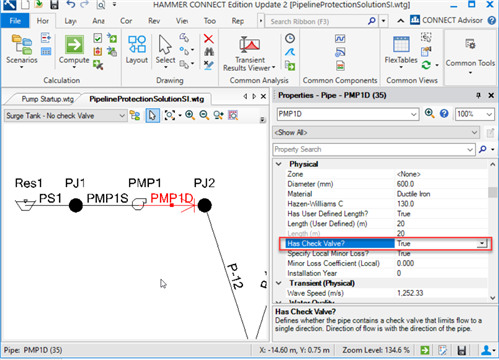| |
Product(s): |
HAMMER |
|
| |
Version(s): |
V8i, CONNECT Edition |
|
| |
Area: |
Modeling |
|
Problem
When modeling an emergency pump shutdown transient event in Hammer, how can I configure check valve or control valve in a pump? How does it work?
What if I don’t want to either model check valve or control valve in a pump as I have check valve element explicitly modeled downstream.
Solution
For the transient simulation, the pump does not necessarily assume a check valve. Under the "Transient (Operational)" section of the pump properties, you can choose between a check valve or a control valve.

When using "shut down after time delay" transient pump type, you have 3 options to select to model a valve in pump that could be check valve or control valve, which needs to be defined pump transient properties as below.
- Check valve
- Control Valve
- Neither a check valve nor a control valve i.e. a separate check valve downstream
OPTION 1
Modeling Check Valve in pump
To model a check valve in pump you need to select check valve as pump valve type in Transient (Operational) properties of pump. An instant closure is assumed, upon first detection of reverse flow. The pump node itself closes, preventing reverse flow. So, the pump speed will also drop to zero when the built-in pump check valve closes (as seen in the Extended Node Data tab of the Transient Results Viewer).
In the case of using the built-in pump check valve, the check valve will not reopen, as the check valve on a pump is designed to close only once and will not reopen. If you want to model check which will reopen upon in the model then you would need to model check valve element separately, which will be mentioned in option 3 (and set the pump valve type to a valve with a long closure delay like 9999 seconds).

OPTION 2
Modeling control valve in pump
To model a control valve in pump during transient analysis you need to select “control valve “in Transient (Operational) properties of pump. You also need to define the Time (For Valve to Close), which means you must enter how long it takes for a built-in valve to close (or open, if the pump is initially off).
This option models a built-in valve that starts closing at the beginning of the transient simulation and becomes fully closed at the time you enter. (closes linearly between time zero and the time you enter) So, if you enter 5 seconds for the “Time (Delay until shutdown)” and 10 seconds for the “Time (For valve to close)”, then the valve starts closing at time zero, is half closed at time 5 seconds when the pump shuts down (applied torque drops to zero) and is fully closed at 10 seconds.
"Diameter (Pump valve)"
The field "Diameter (Pump valve)" comes into picture for this option.
The pump input field "Diameter (Pump valve)" refers to the pump discharge side valve internal diameter and is only used for the internal valve closure calculations during a transient simulation in HAMMER. "Diameter (Pump valve)" is used to calculate the transient response to closure of that valve. Meaning, if you select "Control Valve" for the pump's "Pump Valve Type", the "Diameter (Pump valve)" will be used as the fully open position of the valve (along with the initial flow through the pump), with linear closure of this opening based on the "Time (for valve to close)".

OPTION 3
Modeling a pump that has neither a check valve nor a control valve
To model a separate check valve downstream of pump you can use this option.
When using "shut down after time delay" transient pump type, you must select either "control valve" or "check valve" as the Pump Valve Type. So, if you do not want a check valve or control valve on pump, select "Control Valve" As the pump valve type and enter a large number such as 9999 seconds, as the "Time (For Valve to Close)" to assure that the control valve doesn't impact the results.
Now to simulate the check valve on the pump, you have two options.
First, you can use the check valve element. Place this directly downstream of the pump. The check valve is useful if you need to set the time to open or time to close for a check valve. More information can be found at the Check Valve TechNote. Make sure to set the Downstream Pipe so the check valve is facing the correct direction in the general section of the valve properties

The second option is to open the pipe properties on the pipe directly downstream of the pump and set the property field "Has Check Valve?" to True. This type of check valve assume instant opening and instant closure. This is done by simply selecting “True” for the “Has check valve?” property of the pipe. This would be done on the pipe where the check valve would be located.

See Also
Modeling Reference - Check Valve
Modeling a pump shut down transient event
Modeling a Pump Start-Up Transient Event in HAMMER (V8i and CONNECT Edition)
Modeling a pump startup and shutdown transient event in the same simulation